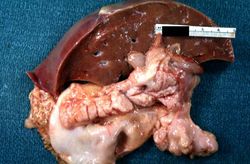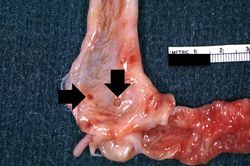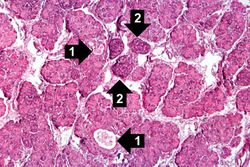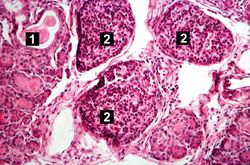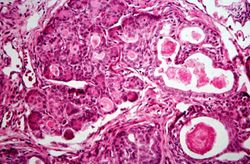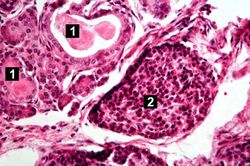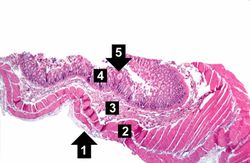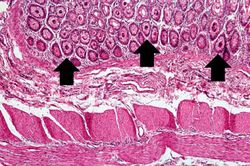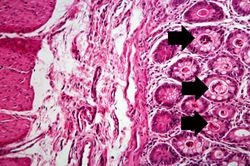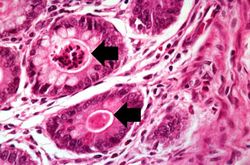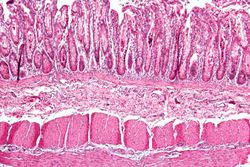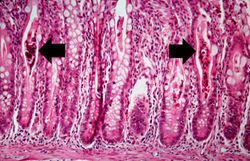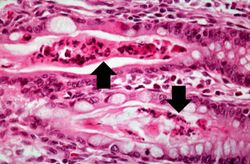Difference between revisions of "IPLab:Lab 13:Cystic Fibrosis"
Seung Park (talk | contribs) |
Seung Park (talk | contribs) |
||
| Line 22: | Line 22: | ||
File:IPLab13CF14.jpg|Another high-power photomicrograph of intestine shows the vacuolated intestinal epithelial cells lining the crypts and necrotic debris and inspissated secretions within the crypts (arrows). | File:IPLab13CF14.jpg|Another high-power photomicrograph of intestine shows the vacuolated intestinal epithelial cells lining the crypts and necrotic debris and inspissated secretions within the crypts (arrows). | ||
</gallery> | </gallery> | ||
| + | |||
| + | == Study Questions == | ||
| + | * <spoiler text="What is the mode of inheritance of cystic fibrosis (CF)?">CF is autosomal recessive. | ||
| + | |||
| + | The frequency of CF in whites is 1/200. Thus, one out of every 20 whites must be heterozygous (heterozygotes have no recognizable symptoms). | ||
| + | |||
| + | Other racial groups have a very low incidence of CF.</spoiler> | ||
| + | * <spoiler text="What is the sweat chloride test?">CF causes altered cellular chloride transport leading to increased chloride levels in the sweat. | ||
| + | |||
| + | A sweat chloride level greater than 60 mEq/L is diagnostic for CF if other clinical signs are also present.</spoiler> | ||
| + | * <spoiler text="What are the most common presenting signs in patients with CF and when do they occur?">When children are 2-12 months of age they develop malodorous steatorrhea and recurrent chronic pulmonary infections. Lower than normal weight gain is also common.</spoiler> | ||
| + | * <spoiler text="What organs are affected by CF?">Lung - chronic pneumonia, viscous mucous secretions, distended bronchioles, hypertrophy and hyperplasia of mucus-secreting glands, chronic bronchitis and bronchiolitis. | ||
| + | |||
| + | Pancreas - atrophy of exocrine pancreas, plugging of ducts, progressive fibrosis and fatty replacement. Insufficiency of exocrine pancreas leads to steatorrhea and fat soluble vitamin deficiencies (e.g., low vitamin K leads to bleeding disorders). | ||
| + | |||
| + | Liver - plugging of bile canaliculi, biliary cirrhosis. | ||
| + | |||
| + | Salivary glands - dilation of ducts, plugging, squamous metaplasia of lining epithelium, fibrosis. | ||
| + | |||
| + | Wolffian duct obstruction - infertility in males who live to puberty.</spoiler> | ||
{{IPLab 13}} | {{IPLab 13}} | ||
[[Category: IPLab:Lab 13]] | [[Category: IPLab:Lab 13]] | ||
Revision as of 16:18, 21 August 2013
Clinical Summary[edit]
This white female infant was the product of an uncomplicated term delivery, though meconium staining was noted at birth. During the first day post-partum, the infant's abdomen became progressively distended and a meconium ileus was suspected. Surgery confirmed the presence of a meconium ileus and a section of perforated atretic jejunum proximal to the ileus was resected. Eight days later, the patient's condition had deteriorated. A second operation revealed a segment of necrotic bowel, which was removed. Subsequently the infant's pulmonary function deteriorated and she required frequent suctioning. She developed repeated episodes of pneumonia (E. coli and Pseudomonas grew out on cultures) complicated by atelectasis secondary to pneumothorax. The patient died at 25-days-of-age in respiratory failure.
Autopsy Findings[edit]
Bilateral, extensive organizing bronchopneumonia was present with evidence of a pneumothorax and atelectasis. There were significant changes in the pancreas consistent with cystic fibrosis as well as involvement of the small intestine and changes related to the surgical procedures.
Images[edit]
Study Questions[edit]
| |||||
Meconium is a dark-green mucilaginous mixture of intestinal secretions and amniotic fluid which is found in the intestine of a full-term fetus. Meconium-stained amniotic fluid, found at delivery, may be an indication of perinatal asphyxia.
Meconium ileus occurs when abnormally viscid meconium completely obstructs the ileum of a newborn.
In alcoholics, aspiration pneumonia is common--bacteria enter the lung via aspiration of gastric contents.
Atelectasis is the collapse of an airway and lung, regardless of the cause, resulting in reduced or absent gas exchange.
A pneumothorax is an accumulation of gas in the pleural space.
Cirrhosis is a liver disease characterized by necrosis, fibrosis, loss of normal liver architecture, and hyperplastic nodules.
